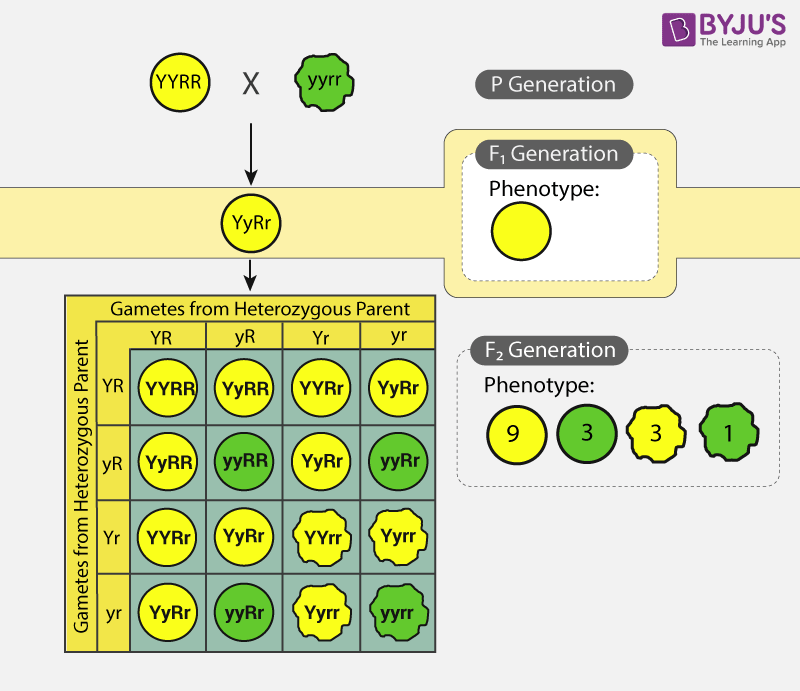“Dihybrid cross is the cross between two different genes that differ in two observed traits.”
Introduction
Gregor Johann Mendel was the first person who discovered the basic principles of heredity during the mid-19th century. Hence, he is known as the “Father of Modern Genetics”. He conducted experiments in his garden on pea plants and observed their pattern of inheritance from one generation to the next generation.
Mendel laid the basic groundwork in the field of genetics and eventually proposed the laws of inheritance. Law of Segregation, Law of Independent Assortment and Law of Dominance are the three laws of inheritance proposed by Gregor Mendel. These laws came into existence from his experiments on pea plants with a variety of traits.
Mendel first studied the inheritance of one gene in the plant through monohybrid cross. He considered only a single character (plant height) on pairs of pea plants with one contrasting trait. Later, he studied the inheritance of two genes in the plant through dihybrid cross.
Mendel studied the following seven characters with contrasting traits:
- Stem height: Tall/dwarf
- Seed shape: Round/wrinkled
- Seed colour: Yellow/green
- Pod colour: Green/yellow
- Pod shape: Inflated/constricted
- Flower colour: Violet/white
- Flower position: Axial/terminal
Also Read: Difference between Monohybrid and Dihybrid Cross
Dihybrid Cross
A dihybrid cross is a breeding experiment between two organisms which are identical hybrids for two traits. In other words, a dihybrid cross is a cross between two organisms, with both being heterozygous for two different traits. The individuals in this type of trait are homozygous for a specific trait. These traits are determined by DNA segments called genes.
In a dihybrid cross, the parents carry different pair of alleles for each trait. One parent carries homozygous dominant allele, while the other one carries homozygous recessive allele. The offsprings produced after the crosses in the F1 generation are all heterozygous for specific traits.

Visualisation of dihybrid cross using a Punnett square
Dihybrid Cross Examples
Mendel took a pair of contradicting traits together for crossing, for example colour and the shape of seeds at a time. He picked the wrinkled-green seed and round-yellow seed and crossed them. He obtained only round-yellow seeds in the F1 generation. This indicated that round shape and yellow colour of seeds are dominant in nature.
Meanwhile, the wrinkled shape and green colour of seeds are recessive traits. Then, F1 progeny was self-pollinated. This resulted in four different combinations of seeds in the F2 generation. They were wrinkled-yellow, round-yellow, wrinkled-green seeds and round-green in the phenotypic ratio of 9:3:3:1.
During monohybrid cross of these traits, he observed the same pattern of dominance and inheritance. The phenotypic ratio 3:1 of yellow and green colour and of round and wrinkled seed shape during monohybrid cross was retained in dihybrid cross as well.
Consider “Y” for yellow seed colour and “y” for green seed colour, “R” for round shaped seeds and “r” for wrinkled seed shape. Thus, the parental genotype will be “YYRR” (yellow-round seeds) and “yyrr” (green-wrinkled seeds).
Also Read: Mendel’s Laws of Inheritance
Explore BYJU’S biology to learn more about dihybrid cross and its examples.
Further Reading:
- Law Of Segregation And Dominance
- Law Of Independent Assortment
- Gene Mutation And Its Types
- Biogenetic Law
Frequently Asked Questions
1. Who is known as the father of modern genetics?
2. What is an example of a Dihybrid cross?
3. How to find the genotype of a Dihybrid cross?
- The first step would be to establish a parental cross (P).
- Next, make a 4×4 (or 16 square) Punnett Square for the chosen traits to be crossed.
- Ascertain the parents’ genotype and assign letters to represent the alleles – use lower case letters for recessive traits and upper case letters for dominant traits.
- Arrange the traits on the square – the logic is that recessive traits emerge only if both the parents have recessive traits. For example, if both the parents have the trait “f”, which is recessive, the emerging trait will be (“ff”). However, if one of the parents have “F”, then the resulting trait will be “Ff”, but never “fF.”

Good explanation
Amazing, really helpful